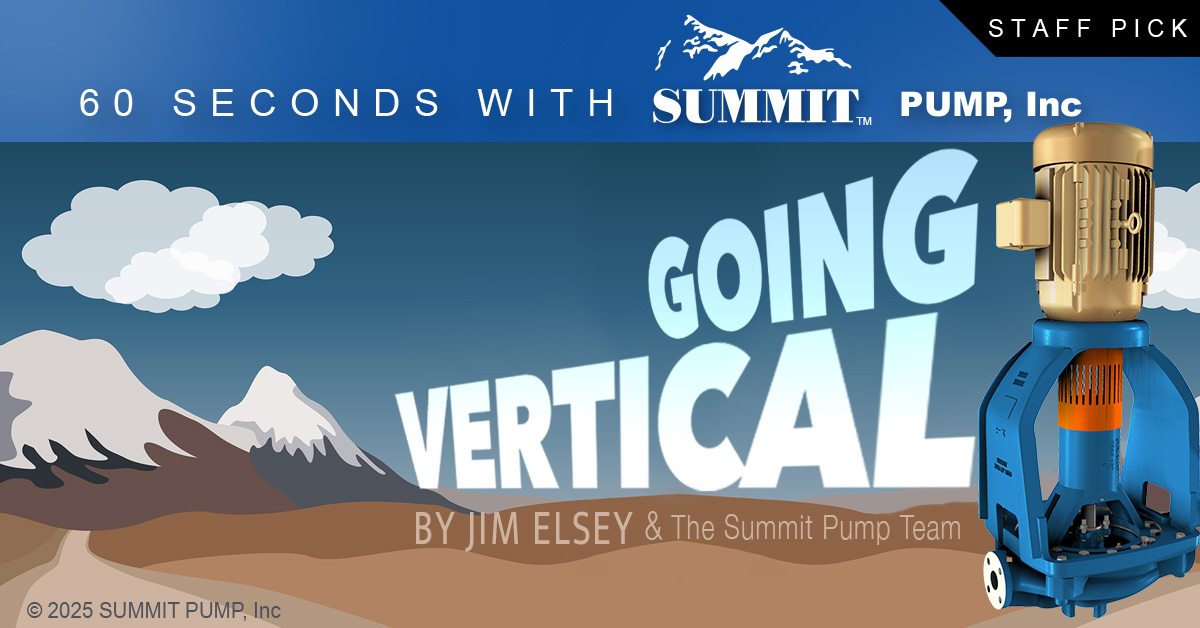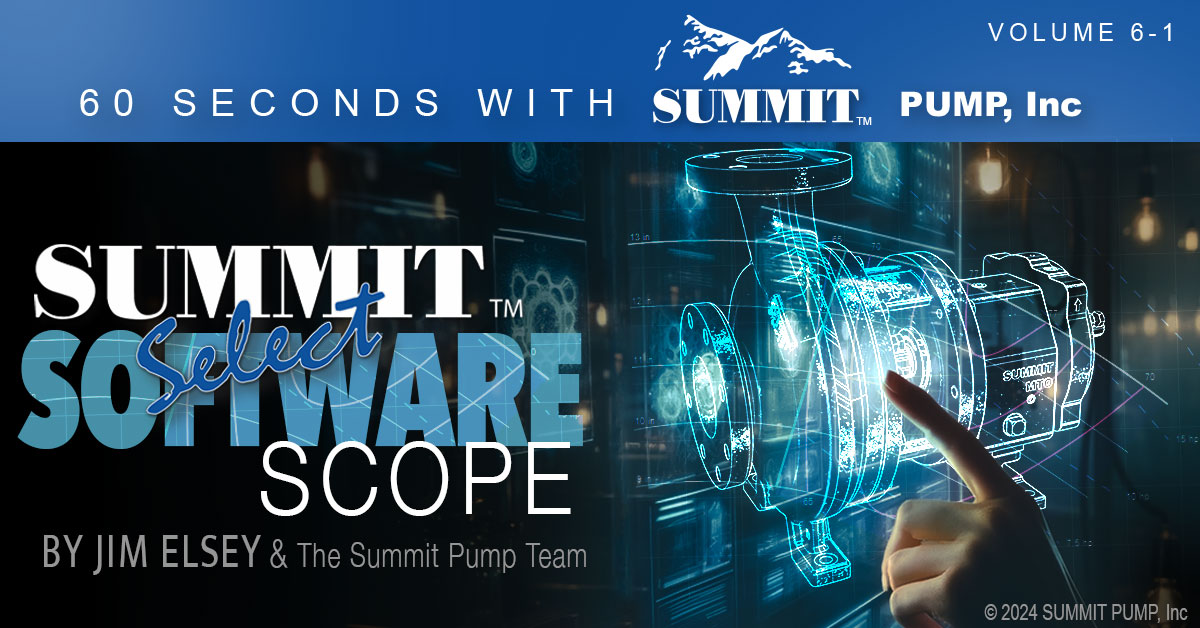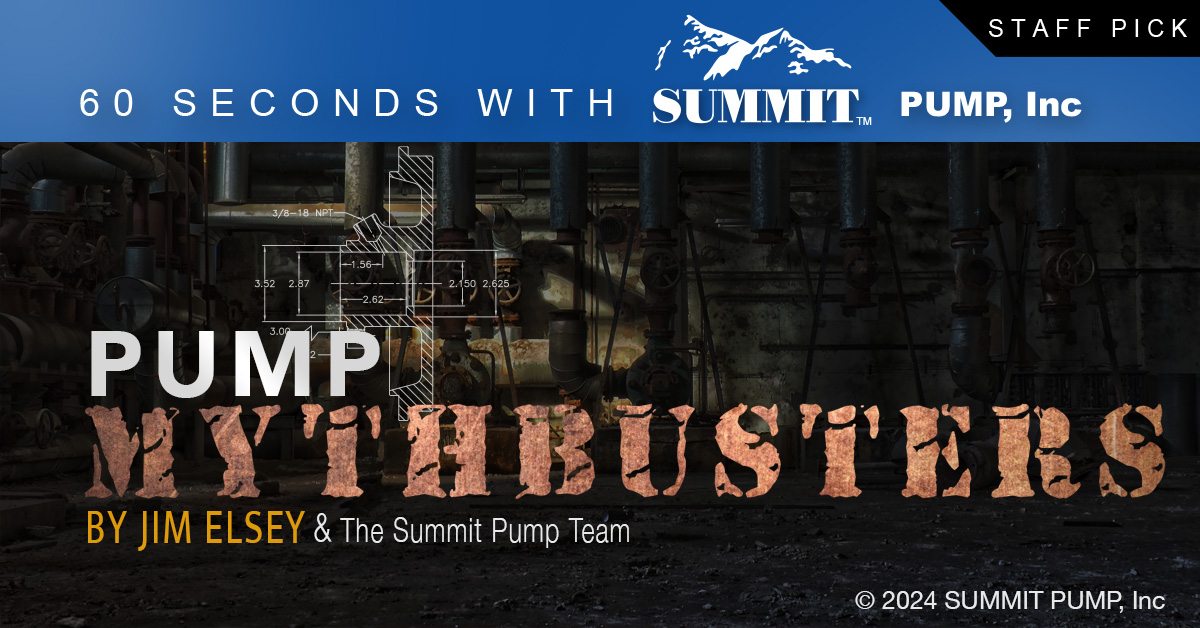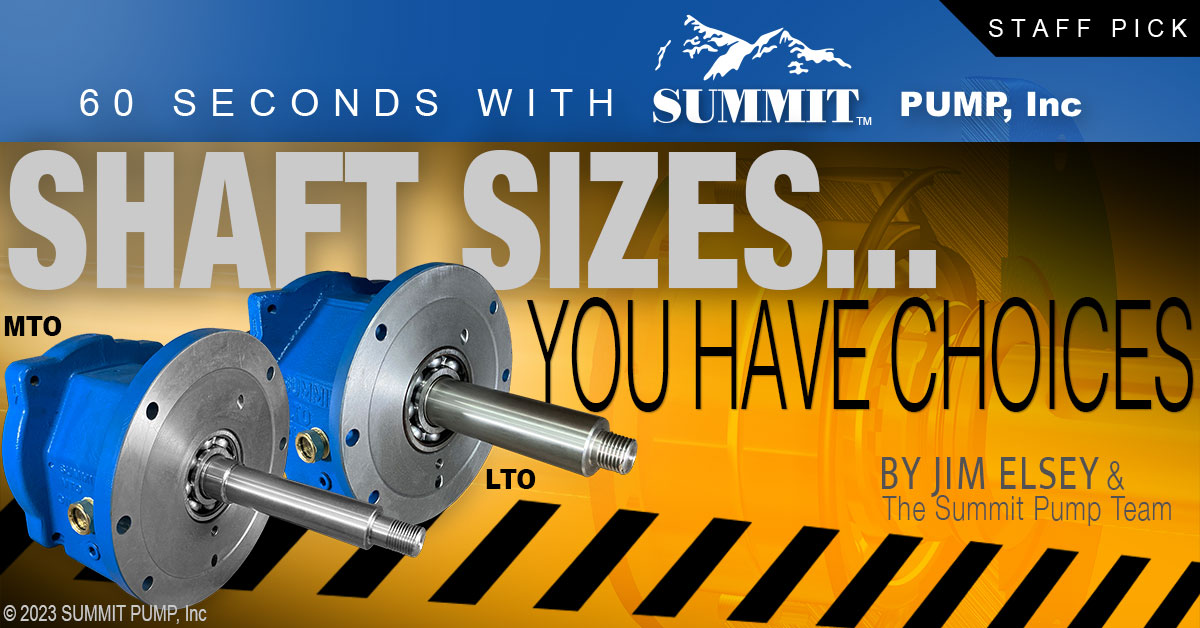
Staff Pick
Going Vertical
Vertical pumps offer a smaller footprint than a horizontal pump of the same size, making them an ideal solution for...
Read More »
Staff Pick
12 Smart Stocking Stuffers For Your Pump
We “regift” these stocking stuffer pump tips to equip you for reliability
in the New Year.

Vol. 6-01
Summit Select Software Scope
Summit Select is a powerful tool for pump selection. The program will assist you in finding the correct pump for your application…when used correctly. Find out how!
Read More »
Staff Pick
Plug & Play Pumps Mythbusted
MYTH: Factory Supplied Pumps are "Plug and Play".
Pumps shipped from the factory are NOT ready to be started when and as received in the field.

Staff Pick
Shaft Sizes...You Have Choices
Most often your competitor will choose the MTO over the LTO version because it is less expensive. However, the astute salesperson will favor the LTO when leveraging reliability, durability and the lower total cost of ownership (TOC).
Read More »
Staff Pick
Why is Your Pump Not Running Right?
“Your pump isn’t producing enough flow!”, “I can’t get enough pressure out of your pump!” “Your pump is making noise!” What’s the Problem? We often get these calls from the field. While it is entirely possible, in reality, it is rarely the pump’s fault.
Read More »
Vol. 5-10
Suction Strainers Starve Pumps
Even the Best-Laid Plans Sometimes go Wrong... The long road to reliable pump life is often paved with good intentions... but sometimes there are unintended consequences.
Read More »
Vol. 5-09
Reverse vs. Open Vane Impellers
ANSI Pump Impellers in the ANSI pump world there are essentially 2 different choices for impellers; open (semi-open) and reverse vane.
Read More »
Vol. 5-08
Deflection Reduction
Reduced shaft deflection results in greater shaft, bearing and mechanical seal longevity. This directly translates to increased reliability with a subsequent decrease in vibration and noise. All these factors will reduce pump total cost of ownership (TCO).
Read More »
Vol. 5-07
Know Your Pump's Viscosity Limit
In the spirit of continuous improvement we like to occasionally remind our readers about important factors that are essential for a successful pump installation.
Read More »
Vol. 5-06
What's Causing Your Leaky Bearing Isolator?
The first modern bearing isolator was patented in 1977. They were initially used in the food processing and chemical industries on pumps and mixers.
Read More »
Vol. 5-05
The Pump Curve is Your Friend
Dylan Thomas is a young pump technician (operator-mechanic) at the local chemical plant. One day he noticed that the batch process on unit C was taking longer than normal.
Read More »
Vol. 5-04
Wear Resistant vs. Wear Proof
In high school, I received a water-resistant watch for my birthday. During the same time, I was also taking SCUBA lessons at the local YMCA. I soon discovered that water resistant does not mean waterproof.
Read More »
Vol. 5-03
Going Vertical
Why a Vertical Pump? Vertical pumps offer a smaller footprint than a horizontal pump of the same size making them an ideal solution for applications with limited space.
Read More »
Vol. 5-02
Pipe Strain: Killer of Pumps
Imagine if you will… You are a conscientious pump technician/owner/operator. You have a strong passion to properly care for the pumps under your safekeeping… your goal is to attain the highest possible level of machine reliability. You do all of the right things to maximize and extend the run time between failures.
Read More »
Vol. 5-01
Fact Check: Plug & Play Pumps
Dispelling the Myth that Factory Supplied Pumps come “Plug and Play”. As an annual ritual, like a reoccuring new years resolution, I am compelled to remind pump industry people that 99.35% (approx.) of industrial centrifugal pumps do not arrive ready to run and play
Read More »
Vol. 4-11
12 Smart Stocking Stuffers for Your Pump
As we near the end of 2021, we “regift” some stocking stuffer pump tips to equip you for a reliable New Year.
Read More »
Vol. 4-10
When to Pay the Piper?
When it comes to system pipe sizing, we confront a ‘pay me now or pay me later’ scenario. Quest for the Optimal Pipe Size You want to pump 600 gpm of liquid from point A to point B. What is the correct pipe size for your new system?
Read More »
Vol. 4-09
Has Your Pump Lost its Head?
Let’s examine a short list of common reasons why your pump may have lost its head. Speed is the main factor in head development for a given impeller diameter. Check that the motor/driver is operating at the correct speed.
Read More »
Vol. 4-08
Do You Have Clearance?
Tips for optimizing pump efficiencies by setting proper impeller clearances. In the ubiquitous world of horizontal ANSI pumps…all share some common dimensions and a back pull-out feature but note there are also two distinctly different styles.
Read More »
Vol. 4-07
The Fourth Alignment
This month, we review the reasoning for multiple pump alignments and why there may actually be more required than you think!
Read More »
Vol. 4-06
Suction Lift
Recently, we investigated numerous issues with mechanical seals failing in self-priming pumps on suction lift applications. In each instance the pump/system was not installed or operated properly.
Read More »
Vol. 4-05
Is Your Pump Stressed? Welcome to Pump Reliability Management: 101
If time and money were no object, the pump OEM would be very happy to design a pump specifically for the customer’s unique operating point; it happens, but not very often.
Read More »
Vol. 4-04
Under Pressure - Part Two: Suction Pressure
Last month we reviewed basic vacuum principles. The reason was to better understand how to correctly measure the differential pressure across an operating pump.
Read More »
Vol. 4-03
Under Pressure – Part One: Pressure vs. Vacuum
The concept of vacuum mystifies some people when encountered on pump applications. Today, we hope to simplify the problem. Pressure vs. Vacuum
Read More »
Vol. 4-02
Deep Submergence
We get calls from the field concerning issues with pumps that are experiencing performance issues.
Read More »
Vol. 4-01
MYTHBUSTED: Factory Supplied Pumps are NOT “Plug and Play”
MYTH: Factory Supplied Pumps are “Plug and Play”. Pumps shipped from the factory are NOT ready to be started when and as received in the field.
Read More »
Vol. 3-11
Thanksgiving with the Pumps. What is Your Pump Grateful For?
Thanksgiving…At this time of year in America we purposefully pause and offer thanks for all we have. Suppose for a minute that in a fictional and make-believe universe you were a pump; what would you give thanks for? We share some ideas.
Read More »
Vol. 3-09
What's the Speed Limit?
How fast was I going officer? Speed is a critical limit for any pump, but even more so for Positive Displacement (PD) pumps. The maximum allowable speed of a PD pump is determined by several factors including the viscosity and temperature of the pumpage.
Read More »
Vol. 3-08
My Self-Priming Pump is Not Priming
I recently received a phone call and subsequent email stating “my self-priming pump is not priming”. Both the phone call and the email were detailed with pictures and appropriate information to start the troubleshooting process.

Vol. 3-07
Gauges!? We Don't Need no Stinking Gauges
Yes! Yes, we do. First, please pardon my paraphrasing of classic movie quotes. However, I think it is a great analogy when talking about gauges in pump systems. Depending on who you talk to … Some people think gauges are extremely important to the overall efficiency of the system, but others do not.
Read More »
Vol. 3-06
Impeller Clearance vs Efficiency
Today we will discuss ANSI pumps with a focus on Summit’s model 2196 product line.
Read More »
Vol. 3-05
Why are there Holes in my Brand New Impeller?
Ever wonder why some impellers, fresh and new from the factory have holes in them? Or… why some impellers have those funny mini vanes on the back side?
Read More »
Vol. 3-04
When is a Flush NOT a Flush?
We have all heard the term “flush” used when discussing mechanical seals.
Read More »
Vol. 3-03
Does Your Snoring Pump Keep You up at Night?
Snoring pumps… ever heard of such a thing? I knew that pumps could run, burp, leak, stall and die (people “kill” them all the time), but I didn’t know that pumps could snore.
Read More »
Vol. 3-02
Valve Positions of Centrifugal Pumps...An Open or Shut Case?
This issue compliments an earlier issue (Volume 1 issue 12 from April 2018) on the same subject. I am frequently asked; should the discharge valve be open or closed when the pump is started?
Read More »
Vol. 3-01
Motor Starts per Unit of Time
Rolling Stone’s front man Mick Jagger’s second favorite song verse is “start me up”…”I’ve been running hot”. Did you also know there are restrictive limits regarding the number of times an induction motor can be started in a given time period?
Read More »
Vol. 2-06
Stocking Stuffers; A gentle reminder of the simple things
I don’t have one particular subject for this month’s issue, but instead a gentle reminder of several simple things. Just a list of pesky issues that keep popping up on a regular basis.
Read More »
Vol. 2-05
Vapor Pressure is Not Your Friend
Be very careful on self-primer lift applications because the liquid temperature directly affects its vapor pressure and that… …changes the Net Positive Suction Head Available (NPSHA).
Read More »
Vol. 2-04
Winter is Coming
For those of us living in the northern hemisphere winter is coming and this message will serve both as a reminder and a warning as to the inevitable arrival of temperatures below freezing.
Read More »
Vol. 2-03
An Easy Open and Shut Case...Or is it?
Open or Closed Tanks and the Effect on NPSHA Calculations When working through NPSHA calculations for pump applications we need to know if the suction supply tank is open to the atmosphere or not.
Read More »
Vol. 2-02
Pumps in Storage...First Do No Harm
Bringing Awareness to Pump Preservation Shelf Life: With the possible exception of Twinkies™*…all things have a finite shelf life. The purpose of this month’s SSWSP is not to go into the details of pump preservation, but to simply make you aware that it is required.
Read More »
Vol. 2-01
Net Positive Suction Head, One Way or Another it is Always Changing.
Here are some brief reminders about NPSHA and NPSHR.
Read More »
Vol. 1-28
My Pump is not Running Right!
“Your pump isn’t producing enough flow!” “I can’t get enough pressure out of your pump!” “Your pump is making noise!” While it is entirely possible, in reality, it is rarely the pump’s fault.
Read More »
Vol. 1-27
Deep Thoughts
No one specific subject or theme this month, just a random collection of tips. Kind of like the junk drawer in my desk.
Read More »
Vol. 1-26
Why is my Stainless Steel Magnetic? ... Or is it?
Several times a month we receive an inquiry from a concerned customer that the “stainless steel” they received from Summit Pump is magnetic and/or appears to be rusting. We assure them there is no issue, and explain as follows.
Read More »
Vol. 1-25
What is slip? How Does it Affect Positive Displacement Pump performance?
What is slip? How does it affect Positive Displacement Pump performance? Is Your Pump Slipping?
Read More »
Vol. 1-24
Baseplates: Flat and Level
Baseplates: Flat and Level Pump Alignments We all know that proper alignments between the pump and the driver are critical. Did you know that the bearing load increases in direct proportion with the misalignment?
Read More »
Vol. 1-23
Truth: Pumps Shipped From the Factory are NOT Ready to be Started and Operated
Once a year I attempt to remind all Summit Pump distributors of the “Plug and Play” myths that unfortunately persist in the pump universe, like fake moon landings and that the earth is flat.
Read More »
Vol. 1-22
You Have Choices
You have choices In the horizontal pump world of ANSI, the (14) mid frame pump sizes offer you a choice of selecting an MTO (medium) or an LTO (large) frame size.
Read More »
Vol. 1-21
NPSHR and Impeller Diameter
Okay, this may take longer than 60 seconds. Prior to computerized software for pump selection, manufacturers simply drew one NPSHR curve for the pump on the head versus capacity curve.
Read More »
Vol. 1-20
API versus ANSI Pumps
There was a relaxation of API 610 9th edition about ten years ago. Consequently, some customers are rightfully trying to save money on applications where API compliance was really not justified. Other people are carelessly obsessed with trying to use an ANSI pump, as an API pump.
Read More »
Vol. 1-19
NPSHR versus NPSHA margins
From several sources I have recently studied: The minimum accepted margin between NPSHR and NPSHA should be a factor of 1.35 times the NPSHRor a minimum of 5 (five) feet (1.524 meters), whichever is greater.
Read More »
Vol. 1-18
Is Your Impeller Balanced?
The purpose of balancing an impeller (rotor) is to ensure a safe and reliable machine. Unbalance refers to the impeller’s (rotor) center-of-gravity (mass) being out of alignment with its center-of-rotation (eccentricity).
Read More »
Vol. 1-17
Pressure Relief Valves: Never Throttle your Safety
Each of Summit Pump’s Internal Gear Pumps come standard with a pressure relief valve. These valves are designed and positioned to protect the pump by SAFETY means only; they are not meant for throttling the flow or pressure of the system.
Read More »
Vol. 1-16
Slurry Applications: What You Don’t Know Can Hurt You.
When pumping a slurry you need to be extremely careful concerning the fluid velocity in the piping. There is a critical carrying velocity for which if the slurry drops below this velocity, the particles will drop out of suspension.
Read More »
Vol. 1-15
Need Some Space?
Did you know that when using an internal gear pump in applications above 225 degrees Fahrenheit or viscosities above 750 SSU, the pump may need extra clearances to operate properly?
Read More »
Vol. 1-14
Do I Really Need to Align my Pump?
Some people still think they can align a pump with a straight-edge, in lieu of a laser or dial-indicator method. They are incorrect. While a straight-edge alignment can potentially kill your bearings, seals and couplings, it also consumes extra horsepower.
Read More »
Vol. 1-13
Overhung Impellers with Solids
When handling solids or trash in the fluid stream, you will experience less clogging issues if using an overhung pump such as our model SN, 2175, 2196 or 2196R versus using a design that incorporates the shaft through the impeller.
Read More »
Vol. 1-12
Open and Closed Case…
What position should the pump discharge valve be in when the pump is started up? My answer is, it depends. For most low to medium specific speed pumps, like our 2196 ANSI pump, having the valve closed or slightly open is preferred.
Read More »
Vol. 1-11
C-Face Motor Adapter Alignment Tolerance
Recently, while teaching pump school for a customer, I was asked a question regarding the alignment tolerance on C-face adapters.
Read More »
Vol. 1-10
Shaft Alignments
We all know that proper and precise coupling alignments between the pump and driver are critical. Did you know that the bearing load increases in direct proportion with the misalignment? Even more importantly, the bearing lifedecreases by the cube of the bearing load increase.
Read More »
Vol. 1-09
API versus ANSI Pumps
There was a relaxation of API 610 9th edition about ten years ago. Consequently, some customers are rightfully trying to save money on applications where API compliance was really not justified. Other people are carelessly obsessed with trying to use an ANSI pump, as an API pump.
Read More »
Vol. 1-08
Shaft Limits
All pumps have a limit as to how much power can be applied before they fail. The limit is defined by using a shaft horsepower limit, which is published in the pump’s IOM Manual. These shaft horsepower limits are based on constanttorque formulas.
Read More »
Vol. 1-07
The Rub with Wear Rings
Pumps with enclosed impellers normally have Casing and/or Impeller Wear Rings, which are sometimes replaceable. Replaceable Wear Rings are usually an earmark of a more expensive pump style, and/or meets a higher specification, such as API 610.
Read More »
Vol. 1-06
Water in the Lube Oil
We keep advising pump owners to keep the water out of their lubricating oil and of course, that is not always the case. A customer recently told me he had no water in his oil because he could “see that the oil was NOT cloudy”.
Read More »
Vol. 1-05
Hot Time
Stuck Impeller Never use heat to remove the impeller for an ANSI pump. Fluid could be trapped in the thread cavity. If that fluid heats to its vapor point you risk an explosion. Pieces of the impeller can cause damage to the surrounding area and more importantly, injury to personnel.
Read More »
Vol. 1-04
Pump “Run Out”
End of the line…. When a pump manufacturer’s published curve stops at the “run out” point (Max Flow at the right side) that is the end of the curve, there is NO more flow and surely no more head.
Read More »
Vol. 1-03
Model SN Pump Shafts
Model SN pumps (Self-Priming Non Clogging) come with either a solid or a sleeved shaft. Most people know to use a solid shaft when the pump is being driven by an engine (internal combustion engines have intermittent versus continuous torque. Consequently, engine driven requires a “beefier” shaft).
Read More »
Vol. 1-02
Threaded Impeller – Reverse Rotation
When an ANSI pump is rotated in the wrong direction, 99% of the time you will know immediately by tripping out the motor on overload. The millisecond the pump starts up, the inertia of the impeller will cause it to unthread and back off on the shaft threads.
Read More »
Vol. 1-01
ANSI 2196 Sight Glass Location
We have recently had a field incident with one of our ANSI pumps; the customer required the oil sight glass to be moved to the opposite side of the pump due to a limited sight issue created by obstructions on the right side.
Read More »